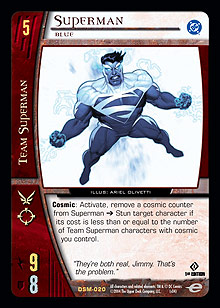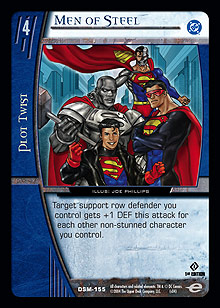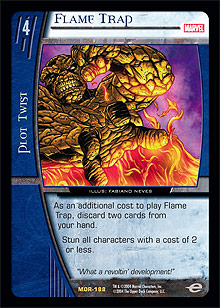Heya guys, I know I’m supposed to be doing a Draft primer this week, but an interesting thing came up at Gen Con. For those of you who diligently watched the coverage, you may have already noticed this yourselves, but for those of you who were a little lax (shame, shame!), I’ll fill you in.
 As expected, the deck to beat coming into the tournament was GLEE. If a deck is good enough to make a contribution to Golden Age with very few changes, it should be a top contender in Modern Age. What wasn’t expected was the degree of utter dominance the deck had in the tournament. Between the PC and $10K Top 8s, there were thirteen GLEE decks, two Qward Stall decks, and one Superman, Blue deck. Thirteen to three. Also, if you check the metagame breakdown from the two events, you’ll see that over two thirds of the players ran some variation on GLEE. This means that a higher percentage of the decks made Top 8 than were played! Why did GLEE dominate the tournaments so much? Don’t worry, brother. Let me break it down for ya.
As expected, the deck to beat coming into the tournament was GLEE. If a deck is good enough to make a contribution to Golden Age with very few changes, it should be a top contender in Modern Age. What wasn’t expected was the degree of utter dominance the deck had in the tournament. Between the PC and $10K Top 8s, there were thirteen GLEE decks, two Qward Stall decks, and one Superman, Blue deck. Thirteen to three. Also, if you check the metagame breakdown from the two events, you’ll see that over two thirds of the players ran some variation on GLEE. This means that a higher percentage of the decks made Top 8 than were played! Why did GLEE dominate the tournaments so much? Don’t worry, brother. Let me break it down for ya.
Where to begin, where to begin? I suppose the easiest place to start is to compare the two sets. Many of you out there are expecting me to come out and say that Green Lantern Corps is just better than Superman, Man of Steel. While in some ways this is true, I don’t think that it’s the main difference between the sets. In Constructed, where everyone has access to all of the same cards, it’s the presence of degenerate cards that really defines a format. Even if there aren’t really any overpowered cards, sometimes two or more cards can work together to make an overpowered effect. Unfortunately, though, sometimes a few overpowered cards can come together and create an effect that dominates a format.
By now, I hope you guys have figured out that the cards to which I’m referring are Dr. Light, Master of Holograms and Kyle Rayner, Last Green Lantern. These cards ruled the PC and the $10K. To be completely fair, Dr. “I Make it Really Hard for You to Lose” Light did most of the dominating, but his little Lantern buddy was certainly around to do more than his fair share of damage to the events. Everyone should know they’re really good by now, but not everyone understands what makes them so good.
 Dr. Light, Master of Holograms is the best card in DC Modern Age, bar none. His potential for abuse with Kyle Rayner, Last Green Lantern, though, isn’t what makes him so insane. That’s just the frosting on the cake. What Dr. Light doesn’t tell you is that he’s the universe’s best reconstructive surgeon. You may think you’ve lost it, but Dr. Light can bring it back for you. More than once over the course of the weekend, I saw a GLEE player’s board decimated and left with only Dr. Light. And more than once I saw them boost an Olapet, play a random other guy or two, and use Dr. Light, and all of a sudden they’ve got five or six little beaters from a board of only one. Having Dr. Light is like having an extra guy every single turn. Your army never seems to die.
Dr. Light, Master of Holograms is the best card in DC Modern Age, bar none. His potential for abuse with Kyle Rayner, Last Green Lantern, though, isn’t what makes him so insane. That’s just the frosting on the cake. What Dr. Light doesn’t tell you is that he’s the universe’s best reconstructive surgeon. You may think you’ve lost it, but Dr. Light can bring it back for you. More than once over the course of the weekend, I saw a GLEE player’s board decimated and left with only Dr. Light. And more than once I saw them boost an Olapet, play a random other guy or two, and use Dr. Light, and all of a sudden they’ve got five or six little beaters from a board of only one. Having Dr. Light is like having an extra guy every single turn. Your army never seems to die.
Kyle Rayner, Last Green Lantern is no slouch, either. Every time he comes into play, he nets you another card. It’s usually a good card, too. Helping Hand, Light Armor, and even the occasional Lanterns In Love were all commonly seen being searched out of players’ decks over the course of the weekend. Add the power level of the cards he usually searches for to the fact that he combos fairly well with a certain Doctor, and it’s easy to see why eleven of the thirteen GLEE decks in the weekend’s Top 8s were running four of him.
Superman, Man of Steel, on the other hand, doesn’t have any broken cards on the level that Green Lantern Corps has. This is one of the main reasons that Superman saw less play than Green Lantern in the tournament. Another design issue that arose relates to curve.
Superman, Man of Steel is very much an on-the-curve set. With the cards in that set, the optimal play is to use all of your resource points each turn by recruiting only one character. This had been rather standard in sets up to that point. Green Lantern Corps, however, was designed to rely heavily on an off-curve strategy. Cards like Olapet, Arisia, and Shock Troops became cornerstones of decks that focused heavily on playing off the curve. This difference in philosophy had a really big impact on the format.
Until Green Lantern Corps, all of the sets had been geared toward playing on the curve. This meant that there was no need to reward players for playing on the curve. For Green Lantern Corps, though, the strategy became somewhat different. Now that there was a new, off-curve strategy, the developers needed to include rewards for the players to entice them to use the strategy. This had happened once before with The New Brotherhood. It was meant as a reward for playing the unorthodox strategy. In GL, the reward cards were incredibly good, especially when used in conjunction with each other. Boosting an Olapet on turn 5 to get an Arisia is the perfect example of this. Add to the fact that Dr. Light only works with the smallest guys in the set, and it’s easy to see why this off-curve strategy took hold.
I suppose I’m not really being fair to the big guys. They do have two distinct advantages when it comes to the little guys. First of all, they are huge. The average 6-drop is 12 ATK/12 DEF. Compare that to the total ATK and DEF of two average 3-drops (8 ATK/8 DEF) and you can definitely see that you get what you pay for. On top of that, when it’s the larger guy’s initiative, he can usually take a few of his buddies and stun a few of the smaller guys at relatively little risk to himself. Despite these advantages, though, the overwhelming number of good support cards for the little guys swung the tournament in their favor.
 While at the PC, one of the things most of the pros commented on about this format was the lack of good defensive plot twists. When looking at Golden Age, though, there are only a few defensive plot twists that see play in that format. I think that the real problem with the defensive plot twists in this format is that they all seem to favor the off-curve decks. Helping Hand and Men of Steel were by far the most played defensive plot twists at Indianapolis. Both of these plot twists favor a deck that has many guys on the board. Curve strategies can’t use these cards as effectively as the off-curve decks. This makes it seem like there aren’t any really good defensive plot twists when the problem is actually that the defensive plot twists are only effective in a very narrow range of deck types. Helping Hand is pretty awful in a deck that only has two or three guys on the table at any given time, but in a deck that frequently has five or six, it’s amazing.
While at the PC, one of the things most of the pros commented on about this format was the lack of good defensive plot twists. When looking at Golden Age, though, there are only a few defensive plot twists that see play in that format. I think that the real problem with the defensive plot twists in this format is that they all seem to favor the off-curve decks. Helping Hand and Men of Steel were by far the most played defensive plot twists at Indianapolis. Both of these plot twists favor a deck that has many guys on the board. Curve strategies can’t use these cards as effectively as the off-curve decks. This makes it seem like there aren’t any really good defensive plot twists when the problem is actually that the defensive plot twists are only effective in a very narrow range of deck types. Helping Hand is pretty awful in a deck that only has two or three guys on the table at any given time, but in a deck that frequently has five or six, it’s amazing.
On top of the supposed lack of defensive plot twists is the overabundance of KO effects. Emerald Twilight and Chopping Block both saw a fair amount of play in Indianapolis. Easy access to KO effects poses a big problem for curve strategies. All an off-curve deck has to do is team attack to stun your bigger guys and then KO them to make a huge impact on your game. Conversely, KO effects do relatively little against an off-curve strategy. Unless the guy that gets KO’d is essential to their strategy, they can simply replay more guys, and it’s almost as if nothing had happened. Simply the threat of running into the loads of KO effects in the format was enough to prevent many curve decks from penetrating the environment.
One of the main things that kept off-curve decks down in the past was the fact that in order for them to have an advantage over the curve decks, they had to use as many of their resources as possible from turn 1 on. In order for this to consistently happen, there has to be an ample amount of search in the format. Fortunately for the off-curve decks in DC Modern Age, Willworld, The Ring Has Chosen, and Emerald Dawn were all printed. This gave the decks the ability to find just about whatever they wanted, whenever they wanted it. Since most of the characters in the GLEE decks were role players, situations arose where you would want a specific one. Thanks to these cards, the off-curve decks had the consistency to keep ahead of the curve decks.
 If all of these cards exist in Modern Age, what’s to prevent this deck from taking over in Golden Age? The simple answer is that there are more cards that hinder an off-curve strategy in Golden Age. Well, maybe more is an understatement. In Modern Age, there are no cards on par with Flame Trap, Search and Destroy, and Total Anarchy. These cards are the first things designers think of when trying to build an off-curve deck. If you can’t deal with them, you’re going to be dead in the water. More than one time over the course of the weekend, I heard someone wishing they had Flame Trap. And the fact of the matter is that it would’ve had a significant impact on the format. Adding one card would have changed the outlook of an entire format. I guess you don’t know what you’ve got until it’s gone.
If all of these cards exist in Modern Age, what’s to prevent this deck from taking over in Golden Age? The simple answer is that there are more cards that hinder an off-curve strategy in Golden Age. Well, maybe more is an understatement. In Modern Age, there are no cards on par with Flame Trap, Search and Destroy, and Total Anarchy. These cards are the first things designers think of when trying to build an off-curve deck. If you can’t deal with them, you’re going to be dead in the water. More than one time over the course of the weekend, I heard someone wishing they had Flame Trap. And the fact of the matter is that it would’ve had a significant impact on the format. Adding one card would have changed the outlook of an entire format. I guess you don’t know what you’ve got until it’s gone.
I hope this gives you some insight into what happened at Indianapolis. I hope you got a better understanding of the format and why things ended up the way they did. Next week (I promise), I’ll be back with the first installment of my Draft primer, so bring your notebooks. School’s back in session.
Questions and comments can be sent to the_priceis_right@yahoo.com.